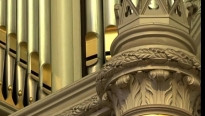
Curious to find out where that world-famous Johannus sound is from? Take a peek behind the musical scenes at Johannus.
The Johannus sound is world-famous. All around the globe, organists are enchanted by the phenomenal pipe organ sounds of our digital organs. What makes the Johannus sound exceptional? And how is it actually created? Take a peek behind the scenes in our world of music. Today we'll feature part 1: the recording.
As the starting point for all the sounds produced by Johannus in recent decades, we chose that unparalleled pipe organ sound each and every time. That is always worth restating before talking about the Johannus sound. Here at Johannus, we all agree that the pipe organ is the undisputed champion. We believe that we cannot make the sound produced by digital organs surpass the completely authentic pipe organ tones.
Even so, Johannus has achieved extraordinary success in translating those authentic sounds into a digital concept. Even experienced organists do not manage to hear the distinction between a Johannus organ and a pipe organ – and we're quite proud of that achievement.
Library
One of the people at Johannus who plays a key role in developing sound quality is Bertus Lap. As a sound technician, he is involved in every step of the process from A to Z, shepherding the shift from cathedral organ tunes to digital organ sounds. That process, Bertus explains, obviously starts in a church. "We start the process by recording pipe organs on site. We take recordings in lots of different churches, so we have a very diverse range of stops and styles in our repertoire. Some at Dutch churches, but we have been all across Europe by now. Those original recordings gave us a vast library containing samples from organs ranging from French symphonic, German baroque, or romantic organs to venerable historic organs."
How do these recordings get made, anyway? "We use high-quality recording equipment which we generally set up in a church in the evening. We place the sophisticated microphones as close as we can to the front of the organ, so we capture the information in great detail. No, we don't put the microphones inside the organ case itself, because the sound there is very different than when you're hearing it from the organ bench or sitting in the church pews. We do take the physical depth of the organ case into account in the recording, however: pipes that are closer to the front sound slightly louder and closer in the end result. That's how we record the original sound as meticulously as possible."
All night long
The recording team starts registering the first stops around 9 in the evening. They continue all night long. Why make the recordings at night? "We start with the loudest stops, because even halfway through the evening, you could still have some background interference from a scooter driving around outside, or crowds murmuring in a city square. As the night progresses, the church grows quieter and quieter, making it possible to record the softer flutes and principals. We generally do about twenty-five stops a night on average."
All the stops are recorded, key by key. The technique Johannus uses is highly distinctive in part because sound and reverb are recorded separately. "Since we record each key individually, we can decouple all the keys from the reverb individually later. It is a fairly complicated process, but it has incredible advantages. It lets us keep the clarity and purity of the original pipe organ sound, and then mimic the intended acoustic effect by using the authentic reverb. If we recorded the organ the way that concerts are recorded – from various positions in the church where sound and reverb blend together – the sound would be much more difficult to fine-tune."
Thanks to the recording technique that Johannus uses, organists can even determine their 'position' in the church from behind their digital organ, whether they prefer to hear the organ the way it would sound from the organist's station on the bench behind the pipe organ, as it would sound from the front-row seats, from the middle of the church, or from a location beyond the scope of the reverb. "We record the reverb in four positions and are capable of digitally translating those differences into the original effect they have on the sounds."
Starter pistol
The reverb used to be recorded by firing a single shot from a starter pistol in the church. This approach encompasses all the frequencies from 16 Hz to about 22 Hz. The reverb from the bang was recorded, and then all the sequences were analyzed digitally. These days, Johannus has a highly advanced speaker that plays a signal from 14 Hz to about 22 Hz (no longer audible to the human ear) within a thirty-second time frame. Combining all the frequencies and associated reverb times into a single moment – a technique also known as deconvolution – achieves the same effect as the starter pistol. However, deconvolution makes it possible to analyze the decay pattern of the individual frequencies, which benefits the quality of the Johannus reverb.
When they're done with a hard night's work, the Johannus recording team heads home with a whole crate full of authentic organ sounds. What happens to the samples between that point and the moment when they resound from the speakers of a Johannus organ in the form of crystal-clear pipe organ sounds and reverbs? Find out in part 2 of this series.